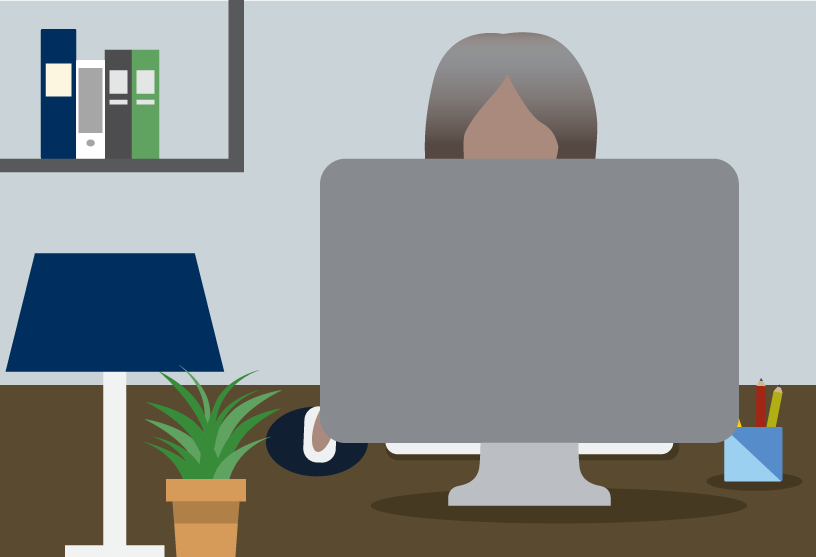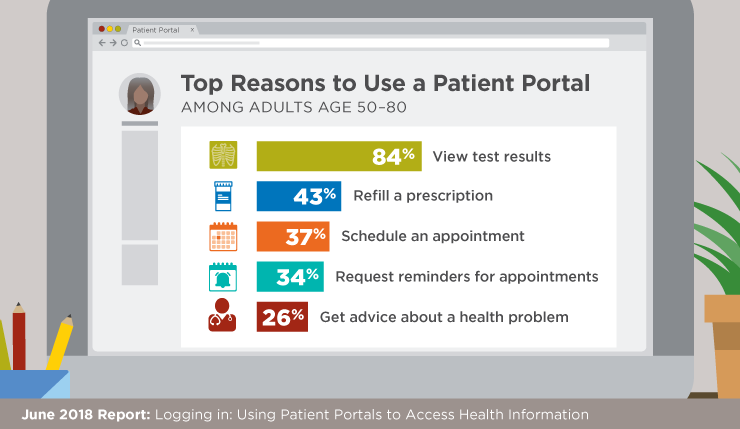
Introduction
Patient portals are secure, personal Internet connections to a health care practice. Portals are hailed as an easy and efficient way for patients and providers to exchange health information. In March 2018, the University of Michigan’s National Poll on Healthy Aging asked a national sample of older adults age 50–80 years about their experiences with patient portals.
Setting Up Patient Portals
About half of older adults (51%) reported they have set up a patient portal, with similar rates for those 50–64 years (52%) and 65–80 years (49%). There were demographic differences, with higher proportions setting up a patient portal among women vs. men (56% vs. 45%), among adults with some college vs. high school only (59% vs. 40%), and among those with higher vs. lower household income (59% for ≥$60,000 vs. 42% for $60,000).
Common reasons cited for not setting up a patient portal were that older adults do not like communicating about their health by computer (40%), do not have a need for a portal (38%), did not know they needed to set something up (33%), have not gotten around to setting up a portal (29%), are not comfortable with technology (26%), and/or their provider does not offer the option of a portal (26%).
Older adults 65–80 years were more likely to say that they do not like communicating about their health by computer (62% vs. 46%) and are not comfortable with technology (47% vs. 30%). Adults 50–64 were more likely to say that they have not gotten around to setting up a portal.
Some adults who have not set up a patient portal had concerns about doing so: 26% were very concerned that there is a greater chance of error with a portal compared to talking with someone by phone or in person. About one in five (18%) were very concerned that they would not know which member of the office staff was answering their question, while 16% were very concerned that it might take too long to get a response to their question or request.
Portals vs Other Methods of Communication
Among adults who have set up a patient portal, the most common use of the portal was to see test results (84%). Other common uses were requesting a prescription refill (43%), scheduling an appointment (37%), requesting reminders about upcoming appointments (34%), getting advice about a health problem (26%), updating insurance or contact information (22%), and requiring a referral (13%).
Among portal users, 43% have authorized another person to see their portal information, most commonly their spouse or partner (37%), an adult child (5%), or another family member (2%). Among users who have not authorized another portal user, 43% said they do not have anyone who helps them with medical care, 35% prefer to keep their medical information private, and 22% do not know how to set up authorized access.
Older adults noted advantages to portals compared with contacting their doctor’s office by phone. With regard to the ability to explain their request, 21% rated the portal as better, 47% rated phone as better, and 32% rated them as about the same. For the amount of time it takes to get a response, 34% said the portal is better, 36% said the phone is better, and 30% said they are about the same. In terms of their ability to understand the information they get from the provider’s office, 30% said the portal is better, 27% said the phone is better, and 43% said they are about the same.

Implications
Patient portals can be important tools to help older adults manage their health care. Portals offer an efficient mechanism to conduct “business tasks”, as well as a way for patients to obtain medical information and advice, without spending time on hold or waiting for a call-back from the doctor’s office. Common uses of portals—such as viewing test results, scheduling an appointment or requesting prescription refills—confirm that many older adults are benefiting from portal technology.
Findings from this National Poll on Healthy Aging highlight some important differences in the use of patient portals by older adults. Higher-income adults and those with more education were more likely than their counterparts to set up a portal. Because lower-income adults often have complex health needs, this finding raises the question of whether patient portals are equitably reaching all populations in need of assistance with managing their health care.
With regard to age, older adults 65–80 identify technology barriers and lack of comfort as key reasons for not setting up a portal. In contrast, adults 50–64 report few specific barriers, but simply have not taken the time to set up a portal.
Many older adults prefer communicating with their doctor’s office by telephone. It is understandable that some patients may prefer a communication method where they can respond in real-time to questions about symptoms or ask for clarification if they do not understand the practice’s instructions. Eliminating barriers to patient portals, while maintaining the option to continue telephone communication, may be the most appropriate strategy to meet the varied needs of older adults.
Data Source and Methods
This National Poll on Healthy Aging report presents findings from a nationally representative household survey conducted exclusively by GfK Custom Research, LLC (GfK), for the University of Michigan’s Institute for Healthcare Policy and Innovation.National Poll on Healthy Aging surveys are conducted using GfK’s KnowledgePanel®, the largest national, probability-based panel in the U.S. Surveys are fielded two to three times a year with a sample of approximately 2,000 KnowledgePanel® members age 50–80.
This survey was administered online in March 2018 to a randomly selected, stratified group of older adults age 50–80 (n=2,013). Respondents were selected from GfK’s web-enabled KnowledgePanel® which closely resembles the U.S. population. The sample was subsequently weighted to reflect population figures from the U.S. Census Bureau.
The completion rate was 74% among panel members contacted to participate. The margin of error is ±1 to 4 percentage points for all the question frequencies, and higher among subgroups.
Findings from the National Poll on Healthy Aging do not represent the opinions of the University of Michigan. The University of Michigan reserves all rights over this material.
Read other National Poll on Healthy Aging reports and about the poll's Michigan findings, and learn about the poll methodology.
Citation
Clark S, Singer D, Solway E, Kirch M, Malani P. Logging in: Using patient portals to access health information. University of Michigan National Poll on Healthy Aging. June 2018. Available at: http://hdl.handle.net/2027.42/145683
Scholarly Publication
Chen J, Malani P, Kullgren JT. Patient portals: Improving the health of older adults by increasing use and access. Health Affairs Blog. September 6, 2018. doi:10.1377/hblog20180830.888175